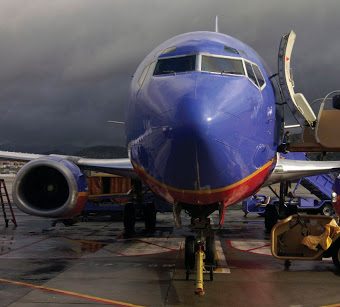Chapter 4: Evaluating the Internal Environment
4.2 Managing Firm Resources
Southwest Airlines: Let Your LUV Flow

In 1971, a new firm named Southwest Airlines opened for business by offering flights between Houston, San Antonio, and its headquarters at Love Field in Dallas. From its initial fleet of three airplanes and three destinations, Southwest has grown to operate hundreds of airplanes in scores of cities. Despite competing in an industry that is infamous for bankruptcies and massive financial losses, Southwest marked its forty-seventh profitable year in a row in 2019.
Why has Southwest succeeded while many other airlines have failed? Historically, the firm has differed from its competitors in a variety of important ways. Most large airlines use a “hub and spoke” system. This type of system routes travelers through a large hub airport on their way from one city to another. Many Delta passengers, for example, end a flight in Atlanta and then take a connecting flight to their actual destination. The inability to travel directly between most pairs of cities adds hours to a traveler’s itinerary and increases the chances of luggage being lost. In contrast, Southwest does not have a hub airport; preferring instead to connect cities directly. This makes flying on Southwest attractive to many travelers.
Southwest has also been more efficient than its rivals. While most airlines use a variety of different airplanes, Southwest operates only one type of jet: the Boeing 737. This means that Southwest can service its fleet much more efficiently than can other airlines. Southwest mechanics need only the know-how to fix one type of airplane, for example, while their counterparts with other firms need a working knowledge of multiple planes. Southwest also gains efficiency by not offering seat assignments in advance, unlike its competitors. This makes the boarding process move much faster, meaning that Southwest’s jets spend more time in the air transporting customers (and making money) and less time at the gate relative to its rivals’ planes.
Organizational culture is the dimension along which Southwest perhaps has differed most from its rivals. The airline industry as a whole suffers from a reputation for mediocre (or worse) service and indifferent (sometimes even surly) employees. In contrast, Southwest enjoys strong loyalty and a sense of teamwork among its employees.
One tangible indicator of this culture is Southwest’s stock ticker symbol. Most companies choose stock ticker symbols that evoke their names. Ford’s ticker symbol is F, for example, and Walmart’s symbol is WMT. When Southwest became a publicly traded company in 1977, executives chose LUV as its ticker symbol. LUV pays a bit of homage to the firm’s humble beginnings at Love Field. More important, however, LUV represents the love that executives have created among employees, between employees and the company, and between customers and the company. This “LUV affair” has long been and remains a huge success. As recently as March 2011, for example, Southwest was ranked fourth on Fortune magazine’s World’s Most Admired Company list.
In early 2020, the US and the world were hit by the coronavirus pandemic. The number of airline passengers dropped by over 90% during the peak months early in the pandemic. Southwest implemented cost saving measures, but still lost $94 million in the first quarter (PRNewswire, 2020). Known for its efficiency, how can Southwest drive down costs to reflect the new reality of less air travel and lower volumes for years to come? Where in its value chain can it not only trim costs but reinvent itself as a more cost effective organization? What resources and capabilities does the airline have to help it re-tool and not only survive the crisis, but come out a sustainable winner for the future?
References
PRNewswire. (2020, April 28). Southwest reports first quarter 2020 results. http://investors.southwest.com/news-and-events/news-releases/2020/04-28-2020-110107839.
Image Credits
Figure 4.1: Seeger, Stuart. “A Southwest Airlines Boeing 737 aircraft parked on the tarmac under cloudy skies at Bob Hope Airport in Burbank, California, United States.” CC BY 2.0. Cropped. Retrieved from https://upload.wikimedia.org/wikipedia/commons/d/d8/Southwest_737_At_Burbank.jpg.

